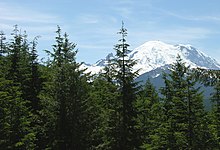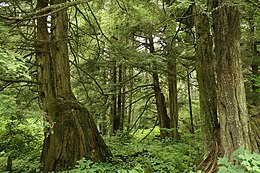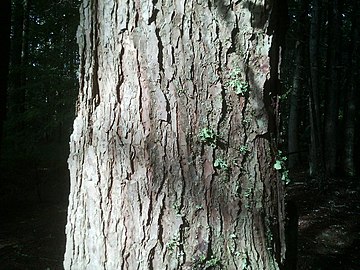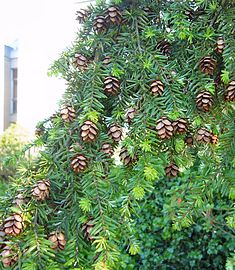Tsuga heterophylla
| Western hemlock | |
|---|---|

| |
| Scientific classification | |
| Kingdom: | Plantae |
| Clade: | Tracheophytes |
| Clade: | Gymnospermae |
| Division: | Pinophyta |
| Class: | Pinopsida |
| Order: | Pinales |
| Family: | Pinaceae |
| Genus: | Tsuga |
| Species: | T. heterophylla
|
| Binomial name | |
| Tsuga heterophylla (
Raf.) Sarg. | |

| |
| Natural range | |
Tsuga heterophylla, the western hemlock[2] or western hemlock-spruce,[3] is a species of hemlock native to the west coast of North America, with its northwestern limit on the Kenai Peninsula, Alaska, and its southeastern limit in northern Sonoma County, California.[4][5] The Latin species name means 'variable leaves'.[6]
Description
Western hemlock is a large
The leaves are needle-like, 5–23 mm (3⁄16–29⁄32 in) long and 1.5–2 mm (1⁄16–3⁄32 in) broad, strongly flattened in cross-section, with a finely
Initial growth is slow; one-year-old seedlings are commonly only 3–5 centimetres (1+1⁄8–2 in) tall, and two-year-old seedlings 10–20 cm (4–8 in) tall. Once established, saplings in full light may have an average growth rate of 50–120 cm (20–47 in) (rarely 140 cm, 55 in) annually until they are 20–30 m (65–100 ft) tall, and in good conditions still 30–40 cm (12–16 in) annually when 40–50 m (130–165 ft) tall. The tallest specimen, 82.83 m (271 ft 9 in) tall, is in Prairie Creek Redwoods State Park, California (United States). The species is long-lived, especially at higher elevations,[6] with trees over 1,200 years old known.[5]
Distribution and habitat

T. heterophylla is an integral component of
Ecology
Western hemlock is a very
Western hemlock forms
Uses
The bark has long served as a source of tannin for tanning leather.[6]
Cultivation
Western hemlock is cultivated as an
It can also be found in large gardens in northwest Europe and southern New Zealand.
Forestry
When planted on the banks of a river, western hemlock can help reduce erosion. Outside of its natural range, the tree is of importance in forestry.
Until the early 1920s, the tree was largely ignored for use as lumber due to its presumed similarity to the poor-quality
It has naturalised in some parts of Great Britain and New Zealand—not so extensively as to be considered an invasive species, but as an introduced one.
Food and medicine
The edible
Western hemlocks have been submerged to collect
Tender new-growth needles can be chewed directly or made into a bitter tea, rich in vitamin C (similar to some other hemlock and pine species).[citation needed]
Culture
Western hemlock is the
References
- . Retrieved 19 November 2021.
- ^ USDA, NRCS (n.d.). "Tsuga heterophylla". The PLANTS Database (plants.usda.gov). Greensboro, North Carolina: National Plant Data Team. Retrieved 12 December 2015.
- ^ BSBI List 2007 (xls). Botanical Society of Britain and Ireland. Archived from the original (xls) on 26 June 2015. Retrieved 17 October 2014.
- ^ ISBN 3-87429-298-3.
- ^ a b c d Gymnosperm Database: Tsuga heterophylla Archived 2005-09-24 at the Wayback Machine
- ^ OCLC 1141235469.
- ^ Tallest Hemlock, M. D. Vaden, Arborist: Tallest known Hemlock, Tsuga heterophylla
- ^ a b Packee, E.C. (1990). "Tsuga heterophylla". In Burns, Russell M.; Honkala, Barbara H. (eds.). Conifers. Silvics of North America. Vol. 1. Washington, D.C.: United States Forest Service (USFS), United States Department of Agriculture (USDA) – via Southern Research Station.
- PMID 17123812. Archived from the original(PDF) on 14 August 2011.
- PMID 21148873.
- ^ "Fungi from decayed wood as ectomycorrhizal symbionts of western hemlock". Archived from the original on 13 March 2018.
- ^ "RHS Plant Selector – Tsuga heterophylla". RHS. Retrieved 5 March 2021.
- ^ "AGM Plants - Ornamental" (PDF). Royal Horticultural Society. July 2017. p. 103. Retrieved 27 December 2018.
- ^ Buckley, Michael (2005). "A basic guide to softwoods and hardwoods" (PDF). worldhardwoods.com. Retrieved 1 October 2017.
- ISBN 0-394-73127-1.
- ^ "State Symbols". Washington State Government. Archived from the original on 15 November 2007. Retrieved 20 February 2022.





